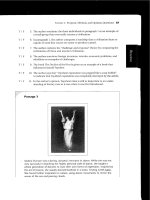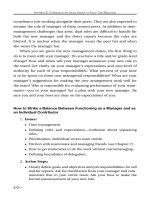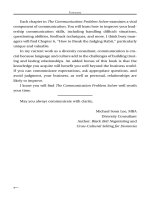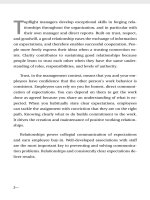The Communication Problem Solver 17 pptx
Bạn đang xem bản rút gọn của tài liệu. Xem và tải ngay bản đầy đủ của tài liệu tại đây (68.1 KB, 10 trang )
H
OW TO
U
SE
Y
OUR
P
ROCESS
S
KILLS TO
P
REVENT AND
S
OLVE
C
OMMUNICATION
P
ROBLEMS
> Develop direct, regular, open communication with boss and staff.
> Be direct when assigning work, not as if you are asking a favor.
> Dress and deport yourself appropriately to your level of manage-
ment.
> Don’t play any favorites and discuss any perceived favoritism
openly. Declare your intention not to play favorites. Ask exactly
what employees saw or heard that led them to think there was
favoritism.
Handling People Problems When Managing Former Peers
You have made your best effort to be understanding and inclusive while
being clear about your expectations. Despite your efforts to initiate com-
munication and prevent problems with former peers, inevitably there
will be some problems at some time during your career. First, check your
own comfort level when giving directions. Even if you are uneasy, you
must assign work clearly with all direct reports. Next, are you managing
the relationship with your boss? If your boss is ill at ease delegating au-
thority to you because you are new in the position, your staff may pick
up on that lack of trust. Work that out with your manager quickly.
1. Issue: The manager needs to cope with a myriad of problems that
can occur with former peers.
2. Problem definition/facts: The former peer may exhibit jealousy
and resentment, may resist your authority, and may not defer to your
guidance. Former peers may think there is favoritism. They may not fol-
low work procedures, they may resist the shuffling of the workload, or
they may resent taking work assignments from a former peer.
3. Action Steps:
> Expect difficulties. Give it time. Embrace the experience and
enjoy the new learning. Management skills grow by successfully
working through these difficulties.
> Deal with problems at the time they occur. Do not procrastinate.
> Keep following the action steps outlined in the previous Prevent-
142—
C
OMMON
P
EOPLE
P
ROBLEMS
—A H
ANDY
R
EFERENCE
ing People Problems section. Focus on being objective and fair.
Revisit the definition of roles/responsibilities and the levels of au-
thority for your position and for your employees’ positions.
> Solicit opinions and feedback to make former peers feel their
opinions are valued.
> Recognize experienced team members by utilizing them as men-
tors or coaches within the team.
> Make all feel valued by giving regular positive feedback and men-
tioning their strengths and accomplishments.
> Work through difficulties with a positive and professional de-
meanor and as much confidence as possible. If needed, speak
one-on-one to clear the air.
> Get management training on communication ASAP.
> When you need to reshuffle the workload of former peers, ac-
knowledge the reality and need for rearranging the work. Explain
the whys. Distribute work equally and according to skill level. Em-
phasize opportunities for growth and development on new tasks
or projects.
> When assigning work to former peers, do the same thing you
would do with all direct reports. Define goals, parameters, and
requirements. Know the capabilities of each staff member and
match them to the tasks. Find out which tasks they prefer and see
if projects can be assigned to match preferences, especially if the
work relates to development goals. Provide the resources to do
the job successfully. Be clear about deadlines and follow up to
ensure they are met. Hold weekly meetings to check on progress.
C. Dealing with Problems with Direct Reports
When She Wanted Your Job
When someone else wanted your new job and was not selected, open
communication with your new direct report is essential. The first time I
was promoted to manage managers, one of the contenders for the posi-
tion had more management experience than I did and was certainly
qualified for the job. She was also a peer with whom I had enjoyed a
friendly relationship. Although we had managed groups in separate de-
—143
H
OW TO
U
SE
Y
OUR
P
ROCESS
S
KILLS TO
P
REVENT AND
S
OLVE
C
OMMUNICATION
P
ROBLEMS
partments, we had supported each other with information and coopera-
tion. Now that I was going to be her manager, we openly discussed the
situation right away. I empathized with her sadness. I said I believed she
could handle the job as well as I could, based on her background and
specific strengths. I wanted the new working relationship to work for
both of us. I asked how we could be a team and make our new unit be
successful. We needed collaboration to pull the merging groups together
into one new unit. She and I strategized a way to work together and
created one of the most cohesive, productive teams I ever experienced.
1. Issue: Working through problems with people who wanted your
job.
2. Problem definition/facts: They may say they deserved the job
and you didn’t. They may try to sabotage your success by making derog-
atory comments about you to coworkers and people outside the depart-
ment. Or they may just be disappointed, but willing to work well with
you.
3. Action steps:
> Have a one-on-one meeting immediately and discuss the situa-
tion openly. Allow the person to express opinions and vent. Listen
to feelings with empathy. Discuss her strengths and achieve-
ments. Tell her you value her on the team and specifically why
her contribution is important. Praise her accomplishments and
skills. Ask how you can work together to make the new roles work
well. Can you delegate special advanced tasks to her? Can she
train and mentor others?
> Define separate roles, responsibilities, and levels of authority.
Keep the chain of command clear and make sure your authority
is not undermined. Build a united team with your boss to gain
support for your level of authority and decision making. Respect
yourself and be confident about the reasons for your selection.
> Keep open communication. Have weekly progress meetings with
each staff member, including this person.
> Help this coworker with a skill development path (without mak-
ing any promises of promotion).
144—
C
OMMON
P
EOPLE
P
ROBLEMS
—A H
ANDY
R
EFERENCE
> Periodically, discuss with this person how she feels about the re-
lationship going forward.
When He Has More Experience
Many managers will hire or acquire direct reports who have more experi-
ence than they do. Some managers report discomfort in managing older
or more experienced direct reports. I faced this challenge as a twenty-
five-year-old first-time manager. Friday I went home as a senior analyst
and Monday I suddenly managed my former peers, almost all of whom
were more experienced than I was. Some had decades of experience in
the company. This is tricky because you cannot change the experience
level you each have. What you have to manage is all the feelings around
that—yours and theirs. Your confidence in the knowledge and skills that
led to your selection as manager is of utmost importance as you execute
your management duties. What were your management strengths that
got you promoted? Honest and open dialogue will also help clear the air
and advance your working relationship.
1. Issue: Managing direct reports who have more experience than
the manager.
2. Problem definition/facts: He has more technical, industry, and
management experience. Since he has been with the company longer,
he has more institutional knowledge. He resents reporting to a person
with less job experience.
3. Action steps:
> Meet with your boss to get clear expectations and levels of au-
thority on responsibilities. Gain your manager’s support and ad-
vice.
> Let go of any fear of being upstaged. Gain trust by demonstrating
your leadership and job expertise. Lead by example.
> Meet one-on-one with the more experienced individual. Clearly
define the meeting agenda and keep on track. Recognize his expe-
rience and past contributions. Discuss how he thinks his knowl-
—145
H
OW TO
U
SE
Y
OUR
P
ROCESS
S
KILLS TO
P
REVENT AND
S
OLVE
C
OMMUNICATION
P
ROBLEMS
edge can best be utilized going forward. Ask what new projects or
career challenges might use his expertise. Ask what works best
for him regarding types of tasks and how they are assigned and
monitored.
> Collaborate on a way to proceed with his interests aligned with
team interests. If he is qualified, invite him to lead others or desig-
nate him as your back up. Ask him to mentor or teach less experi-
enced or newer staff. Set those opportunities in motion.
> Provide opportunity to showcase his talent and knowledge. Rein-
force the high level of experience by giving high visibility projects.
Embrace his knowledge and let the team know you appreciate it.
> Clear the air with regular, open one-on-one discussions. Tell him
how his contribution impacts the organization/team and why.
> Consider his views on how to collaborate on projects, problem
analysis, decisions, and planning. Ask his opinions on goals and
strategies best for the team. Listen/be receptive to learning from
him. Defer or delegate appropriate decisions to give him owner-
ship. Keep him in the loop about goals, plans, and changes. Solicit
his support. Use him as a resource. Ask for his opinions and rein-
force his value to the project.
> Flex and adapt your communication style to best work with his
style. (There are a number of style assessments available. Check
with your Human Resources department, read up, or take a man-
agement class that includes styles.)
> Identify and support any skill gaps he has and give him chances
to work in areas that would develop those skills. Keep challenging
him for continued growth. Ask him what he wants to learn and
what his career goals are. Support his career path development.
> Keep him busy and give regular feedback.
> Be flexible, firm, and fair, just like you are with all employees.
When She Went Around You to Your Boss
At some point in your career, you may have a direct report who goes
directly to your boss to get what she wants instead of going through you.
She knows you will find out and that will cause more communication
problems with you, so that employee is communicating something indi-
rectly to you. It happened to me when I was on a lengthy business trip
146—
C
OMMON
P
EOPLE
P
ROBLEMS
—A H
ANDY
R
EFERENCE
in the United Kingdom. I came back to find out a manager who reported
to me had gone to my boss and requested that he become the project
manager on a worldwide project we were about to begin. Ironically, it
was a good idea. It just was not done properly. He should have contacted
me when I was in Europe, but chose to go to my boss instead. I realized
that I did not have direct, open communication with this employee and
that was the problem underlying the fact that he went to my boss. When
your direct report goes around you, it is up to you to get communication
back on track.
1. Issue: How to handle the situation when a direct report goes to
your boss, and how to prevent it from recurring.
2. Problem definition/facts: Your employee did not discuss her re-
quest, suggestion, or complaint with you. Instead, she went directly to
your boss. She did not communicate directly with you, but indirectly.
Does she not trust you? Does she not think you are capable in your posi-
tion? Is she afraid it will cause a confrontation if she speaks to you di-
rectly? Might you not give her what she wants? You probably do not
know why she chose to not communicate with you until you ask her.
3. Action steps:
> Discuss the situation with your boss and get agreement about
how your boss will handle it next time by referring the person
back to you. Get support that your boss will back you up in the
meeting you are about to have with your direct report. Work back
and forth with your manager until you are in complete agreement
about the communication you are about to have with your direct
report.
> Make sure you have your emotions under control and you can
conduct a neutral, fact-based conversation with your employee.
> Hold a one-on-one meeting with the direct report (face-to-face if
possible, and at least voice-to-voice if it can’t be in person).
• Acknowledge what happened. Give direct eye contact. Ask why
she went directly to your boss and listen carefully to her an-
swers. Ask more open questions in a neutral tone until you cut
—147
H
OW TO
U
SE
Y
OUR
P
ROCESS
S
KILLS TO
P
REVENT AND
S
OLVE
C
OMMUNICATION
P
ROBLEMS
through all the excuses and find out the real reason. Explore
the situation, ‘‘Can you help me understand why you went di-
rectly to my boss?’’
• State why it was inappropriate. Discuss reasons for not going
directly to your manager. Tell her that you and your boss are in
agreement about this and what will happen if she goes to your
boss again.
• Tell her you want to work well together and that communica-
tion needs to improve between you so that the work can get
done appropriately. Communication is part of her job (if that is
stated on her job description, show it to her). Get her agree-
ment to improve communication. Put the onus on the em-
ployee. Ask ‘‘How do you think we should handle this?’’ Clarify
her expectations of what she thinks you can do differently. If
appropriate, agree to what you can change in the interest of the
job. Ask what she will do differently. Clarify.
• Have your own idea of what needs to happen and discuss. State
‘‘This is what I expect . . .’’ and ask ‘‘Is there something I can
do to help you be more comfortable with this situation?’’
• Have employee restate the expectation and what she will do to
meet it.
When He Is a Great Strategist but Can’t Complete Tasks
When a person is an innovator and a great strategist, he has a concep-
tual, big-picture way of looking at the work. These abilities are essential
for certain work, for example, starting a new department or creating new
products and services or other projects that have not been done before.
These skills are not needed for jobs that require following policy and
procedure or doing things that are routine and must be done a certain
way. The first question to ask when the strategist cannot complete tasks
is, ‘‘Are his qualifications well matched with job requirements?’’ He may
be in the wrong job. If he is matched appropriately to the work, a per-
formance problem may be emerging.
1. Issue: How to deal with a manager (direct report) who has great
ideas and is a good strategist but who can’t focus on getting tasks com-
pleted.
148—
C
OMMON
P
EOPLE
P
ROBLEMS
—A H
ANDY
R
EFERENCE
2. Problem definition/facts: Direct report (who also is a manager)
missed the last two deadlines. He did not prioritize his team’s projects
or the tasks within those projects last month. He surfs the Internet, en-
gages in water cooler talk, and spends an hour a day on personal phone
calls. He does not delegate to staff members. He creates effective strate-
gies and contributes innovative ideas and approaches that save the com-
pany time and money. The manager of this direct report must separate
the two issues of his strategic contribution and the management duties
he is currently not accomplishing. The focus here needs to be on what
changed in the last month and how to get him back on target.
3. Action steps:
> Ask questions to determine how well the employee thinks he is
matched to the job, what has changed in the last month that he
didn’t prioritize projects and began missing deadlines, and what
he can do to handle the situation.
> Have the employee clarify the expectations for schedules and re-
sponsibility to prioritize. Keep him focused on task at hand rather
than big picture if that is the job requirement. Define milestones
and checkpoints in the projects. Follow up weekly or twice a week
for a while—monthly is too long between your progress check-
ins. Find out what is helpful to the employee in completing tasks.
Explain resources and tools available.
> Refer to company policy on Internet and personal phone time
and discuss impact on the work. Define your expectations and
get his agreement to comply with them.
> Discuss strategies for delegating, and have him review his priorit-
ies. Provide training for time management and delegation if
needed.
> Ask how the employee’s creative ideas can be addressed and per-
haps used to better the workflow, processes, or organizational in-
terests. Assign challenging projects that require innovative ideas.
When She Does Too Much Personal Stuff at Work
What if your direct report spends a lot of time doing personal things at
work? There are many considerations before you tackle this one. Is the
—149
H
OW TO
U
SE
Y
OUR
P
ROCESS
S
KILLS TO
P
REVENT AND
S
OLVE
C
OMMUNICATION
P
ROBLEMS
person working a lot of uncompensated extra hours (like working with
people overseas at night) and needs to catch up on personal stuff during
daytime hours? Is it really a problem for the work and the team? Is the
individual’s performance affected? If you conclude that your direct re-
port or team’s performance is affected, or the direct report could be
more productive and take on more tasks, then you might want to choose
some of the action items delineated by a manager who had this problem.
1. Issue: How to ask people to spend far less time doing personal
stuff instead of working.
2. Problem definition/facts: The manager observed the employee
doing social networking on the phone and on nonwork Internet sites
over the last month. He does not know how much time the employee is
spending doing personal activities, but he doesn’t think she should do it
at all. The manager made a joke about it once but the behavior didn’t
change.
3. Action steps:
> Determine exactly how much personal time is being spent on the
job. Is it worth discussing?
> Discuss what’s going on that is causing the personal time. Listen
and empathize. State the company policy on computer and
phone use. Get agreement on compliance to policy.
> Outline important tasks in priority order. Discuss actual perfor-
mance compared to what is expected. If the employee is not
meeting job requirements, discuss what is needed to perform sat-
isfactorily. If the employee is meeting expectations and has extra
time, can she take on additional or more challenging assign-
ments? Check the appropriate workload.
> Ensure deadlines are set and clearly understood. Temporarily im-
plement shorter-term checkpoints. Agree what the employee
needs to accomplish so you can stretch out the time between
checkpoints.
> Calculate the hourly compensation and multiply it by the number
of hours per day, week, or month spent on personal issues. This
150—
C
OMMON
P
EOPLE
P
ROBLEMS
—A H
ANDY
R
EFERENCE
is the cost to the company, and probably the person has not
thought of it in those terms.
> If appropriate, educate the person on the ethics of exchanging
work for compensation.
> Discuss distractions to other teammates and the necessity to role
model good work habits.
When a Good Performer Star ts to Come to Work Late
When performance suddenly changes, it is important to address it right
away and see what caused the shift. If this is a new occurrence, it is best
to approach the situation gently and get the facts of what has changed
for the employee. At one client company I consulted with, a valued em-
ployee began coming to work ten minutes late every morning. His wise
manager took a gentle approach and discovered that the employee had
no car and the bus schedule had changed. The earliest the employee
could get to work was on that bus. The company flexed his schedule for
him even though it was a manufacturing job that had strict hours. The
company kept an outstanding employee by finding out the cause and
providing a workable solution. You might not be able to flex hours or see
the need to do that.
1. Issue: What to do when a good performer starts coming to work
late.
2. Problem definition/facts: Work hours are important to the nature
of this job. The employee is needed at the workstation on time and has
begun to be late. The cause is unknown.
3. Action steps:
> Follow the feedback process described in Chapter 8 of this book.
> The first time you notice lateness, immediately discuss it with
employee. This teaches the employee that the behavior was no-
ticed and that the policy is important. It also teaches the rest of
the staff that you intend to enforce the policy.
—151









